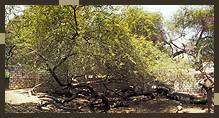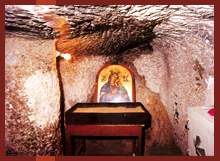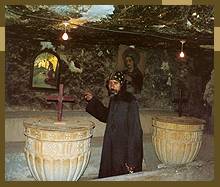THE
HOLY FAMILY AT MAADI
After
their short stay in Old Cairo, the Holy Family moved in a
southerly direction, reaching the modern Cairo suburb of Maadi
which, in earliest Pharaonic times, was an outlying district
of Memphis, then the capital of Egypt. At Maadi, they boarded
a sailing boat which carried them up the Nile towards southern
Egypt. The historic church built upon the spot from which
they embarked, also dedicated to the Virgin, is also known
as 'Al-Adaweya', the Virgin's Church 'of the Ferry'. (In fact,
the name of the modern suburb, Maadi, derives from the Arabic
word meaning 'the Crossing Point').
 The Holy Bible - Virgin Mary Church -
Maadi
The Holy Bible - Virgin Mary Church -
Maadi |
The
stone steps leading down to the River's bank, and believed
to have been used by the Holy Family, are accessible to pilgrims
through the Church courtyard.
An
event of miraculous importance occurred on Friday the 3rd
of the Coptic month of Baramhat - 12 March 1976 A.D. A Holy
Bible of unknown provenance was carried by the lapping ripples
of the nile to the bank below the Church. It was open to the
page of Isaiah 19:25 'Blessed be Egypt My People'.
The Bible is now found in the Sanctuary of the Virgin.
THE
HOLY FAMILY AT AL GARNOUS MONASTERY - MAGHAGHA
The
sail boat docked at the village of Deir Al-Garnous (the later
site of the Monastery of Arganos) 10 kms west of Ashnein el
Nassara (a small village near the town of Maghagha). Outside
the western wall of the church of Virgin, a deep well is believed
to have provided the Holy Family with the water they needed.
THE
HOLY FAMILY AT AL BAHNASSA
They went from there to a spot later named Abai Issous, 'the
home of Jesus', the site of present day Sandafa village, east
of Al Bahnassa which stands some 17kms west of the town of
Beni Mazar.
GABAL
AL TAIR - SAMALOUT
 Al-Abed (the Worshipper's) Tree - nazlet
Ebeid - Minia
Al-Abed (the Worshipper's) Tree - nazlet
Ebeid - Minia |
They
travelled south from Bahnassa to Samalout and crossed the
Nile to the spot on the east bank of the River where the Monastery
of the Virgin now stands upon Gabal El-Tair ("Bird Mountain')
east of Samalout, 2Kms south of Meadeyat Beni Khaled. It is
known by the name Gabal El-Tair because thousands of birds
gather there. The Holy Family rested in the cave which is
now located inside the ancient church there. Gabal El-Tair
is also called Gabal El-Kaf ('Palm Mountain'). Coptic tradition
maintains that, as the Holy Family rested in the shade of
the Mountain, Jesus stretched His little hand to hold back
a rock which was about to detach itself from the mountain-side
and fall upon them. The imprint of His palm is still visible.
When
they resumed their travels, the Holy Family passed a laurel
tree south of Gabal El-Tair, along the pathway flanking the
Nile and leading from the Mountain to Nazlet Ebeid and the
new Minia Bridge. It is claimed that this tree bowed to worship
the Lord Christ as He was passing. The configuration of the
Tree is indeed, unique: all its branches incline downwards,
trailing on the ground, then turn upwards again, covered in
a cloak of green leaves. The tree is called Al Abed - "The
Worshipper".
THE
HOLY FAMILY AT AL ASHMOUNEIN TOWN - MALAWY
Once
more crossing the Nile, back to its west bank, the Holy Family
travelled southwards to the town of Al-Ashmounein- or Hermopolis
Magna.
|

|
Leaving
behind them the rubble of fallen idols, they continued in
a southerly direction, for another 20 kms to Dairout Al-Sharif
(which, like Al-Ashmounein, had an alternative Greek name:
Philes); and thence to Qussqam (or Qost-Qoussia).
 The Crypt of Virgin Mary Church - Gabal
El-Tair - Samalout
The Crypt of Virgin Mary Church - Gabal
El-Tair - Samalout |
Here,
too, the recorded events testify that the townsfolk were infuriated
when the stone statue of their local deity cracked and fell,
and evicted the Holy Family from the town. A historically
recorded incident dating to that period refers to the devastation
of Qussqam, and Coptic tradition asserts that the ruin that
befell the town was the consequence of its violent rejection
of the gentle visitors.
This
contrasts with the warm welcome the holy refugees met at their
next stop Meir (or Meira) only 7 kms west of Qoussia. Here,
they found consideration and hospitality wherever they went,
for which treatment the town and its people were blessed.
THE
HOLY FAMILY AT MOUNT QUSSQAM
Now
it was time for the Holy Family to set out for what is, the
most meaningful destination of all in the land of Egypt, the
place where there would be 'an altar to the Lord in the midst
of the land of Egypt'. Gabal (Mount) Qussqam, which takes
its name from the town nearby , is 327 kms south of Cairo,
and stands in the Governorate of Assiut. The Monastery of
Al-Moharraq nestles against the western foothills of the Mountain.
It
was built around the area where the Holy Family remained just
over six months. Their time was spent mainly in a cave which
became, in the Coptic era, the altar of the Church of Virgin
Mary, built at the western end of the Monastery compound.
The altar-stone was the resting place of the Child Jesus during
the months He dwelt there.
The
whole area - the Monastery and its surroundings - is redolent
of the Coptic Christian ethos. So hallowed are its intimations,
that the Copts of Egypt named it the Second Bethlehem.
It
was here, at the very spot where Al-Muharraq Monastery stands,
that the Angel of the Lord appeared to Joseph in a dream,
and said "Arise, and take the young Child and His mother,
and go into the land of Israel; for they are dead which sought
the young Child's life" (Matthew 2:20 & 21).
THE
RETURN
They
then set forth on the return journey. The route they took
deviated slightly from the one by which they had come. It
took them to Mount Dronka, 8 kms south-west of the city of
Assiut, and their blessing of this location was commemorated
in the Christian era by the building of the Mountain-top Monastery
of Dronka.
Eventually,
they arrived at Old Cairo, then Matariyah, and on to Mahamma,
retracing more or less their steps on their outward journey
across Sinai to Palestine.
Subsequent
Biblical history says it all. At the end, they arrived home,
Joseph's old house, in the small town of Nazareth, in Galilee,
in the land of Palestine, from where the message of Christ
would, in the fulness of time, be heard.

Chrismatories at the Monastery |
The
whole journey, from the initial flight from Bethlehem to the
return to Nazareth lasted over three years, and covered 200kms.
Their means of transport was a weak beast of burden and the
occasional sail-boat on the Nile. But for most of the way,
the delicate Mother and the rugged old Carpenter must have
trudged on foot, enduring the fierce summer heat and the biting
winter's cold, suffer hunger and thirst. It was a jouney of
indescribable agony and anguish which the Child Jesus, His
Virgin Mother and Saint Joseph bore with inner joy, and survived
for the sake of mankind.
|
|